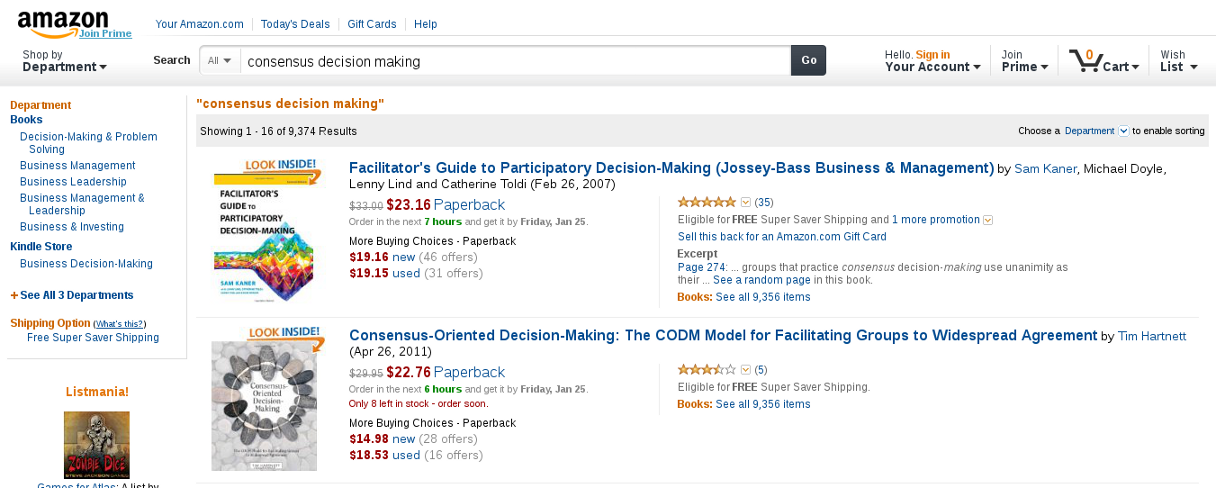User:Eleanorg/thesis/draft1.1/book covers
Search for 'Consensus Decision Making' on Amazon and consider the first two results (Amazon.com, 2013). One: Facilitator's Guide to Participatory Decision-Making. I first encountered this book on my lunch break while working as a facilitator at an activist charity. It is a familiar face on the bookshelves of friends and like-minded folk - a bible perhaps, outlining the process of reaching decisions consensually. The second is another consensus manual I don't yet know. It promises a "clear and efficient path to generating widespread agreement while fostering full participation and true collaboration" (Hartnett, T. 2013).
What struck me about these top two books was their covers. The first one features a colour detail of one of the book's key diagrams - the 'diamond of consensus'. So-called because the group begins from a point of affinity (a narrow, huddled zone), and through the process of decision-making airs its differences, desires and conflicts (a wide zone of deliberation, dubbed "the groan zone"), finally to converge narrowly again, upon an outcome agreeable to all. It is this last phase which is privileged on the cover of the second book, in which a circle of stones are aligned in such a way that each one's individual marking connects to the others to form a coherent and peaceful pattern. Individual difference is subsumed by the eye's desire for the striking circular pattern. The smooth restful pebbles of meditation books and motivational calendars: harmony, peace and unity. The 'clear and efficient path'. By contrast, it is the central 'groan zone' that is privileged on the cover of the other book, in full exuberant colour. It is a jagged space of zig-zag lines, in strongly contrasting (though complementary) colours, peopled by isolated dots jostling for attention, and rendered in watercolour and wax which resist each other.
I tracked down the illustrator of this book cover, Karen Kerney, who explained her inspiration:
"I was currently working in a whole grain baking cooperative, daily dealing with group dynamics and decision making so I had a keen interest in the subject. My illustration tended to reflect a group going along in the river of life...flowing along... When the issues arise that need a group's attention, I think that life gets bigger (like the diamond shape)...every thing is expanded...energy levels rise...creativity flows... If we handle the chaos and confusion as a natural integral part of the decision making process (not to be avoided), we build skills, trust, experience and come to know that we can move forward and evolve as a group. This was my experience at the bakery..." (Kerney 2013)
These two book covers offer two contrasting visions of consensus process, and thus, perhaps, of consent itself. On the one hand, the egalitarian harmony of the perfect circle; on the other, a space containing difference. The latter, argues Kerney, is necessary for the former - there can be no consensus while "chaos and confusion" are suppressed. Perhaps these two illustrations also offer two contrasting justifications for attempting to establish consent. It is easy to endorse a process for its 'efficient path' to an outcome everyone will agree to. (Scroll down your Amazon results for plenty of business books stressing the "high commitment decisions" and "problem solving" offered by consensus decision-making - echoing the feminist rhetoric that "consent improves your love life" (find quotes)). But I am arrested by the Facilitator's Guide cover and its insistent, proud privileging of this colourful groan zone. This zone is a means to an end, for sure, but as Kerney explains, that end may not be the obvious one of a harmonious group decision. In this wide diamond, in this wax and watercolour confusion-zone, lies another way of thinking about our dealings with others. On the cover of this edition it is cropped before the diamond closes and convergence happens. Perhaps this is OK; perhaps this closure is sometimes a shame. Perhaps the groan zone could be an end in itself.

